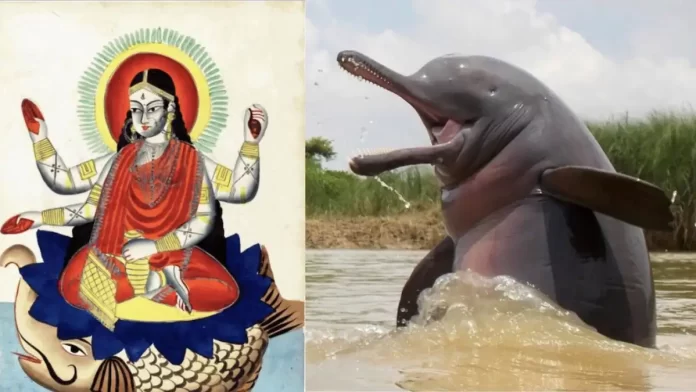The Ganga Dolphin, also known as the Gangetic Dolphin or the South Asian river dolphin, is a charismatic and endangered species native to the rivers of India and Bangladesh.
Known for its unique appearance and importance in cultural and ecological aspects, the Ganga Dolphin has captured the hearts of people worldwide. In this article, we explore ten fascinating facts about this remarkable creature.
Ancient Heritage
The Ganga Dolphin has a rich history intertwined with Indian mythology and folklore. It is mentioned in ancient Hindu texts, where it is believed to be the vehicle of the river goddess Ganga, and is often depicted alongside gods and goddesses.
Species and Classification
Scientifically known as Platanista gangetica, the Ganga Dolphin belongs to the family Platanistidae. It is one of only four freshwater dolphin species in the world, and the only one found in Asia.
Unique Physical Characteristics
The Ganga Dolphin has a long, slender body with a pronounced hump on its back instead of a dorsal fin. Its beak is elongated, and it lacks teeth in its upper jaw, making it different from other dolphin species.
Blind but Skilled Echolocation
Ganga Dolphins are almost completely blind due to their eyes’ underdeveloped state, likely as an adaptation to their murky river habitats. However, they use echolocation, emitting high-frequency clicks, to navigate, communicate, and find prey in the turbid waters.
Habitat and Distribution
These dolphins primarily inhabit the freshwater rivers of the Indian subcontinent, including the Ganges, Brahmaputra, and Meghna river systems. They prefer deeper pools and eddies, where they can find fish, their primary food source.
Endangered Status
The Ganga Dolphin is classified as an endangered species by the International Union for Conservation of Nature (IUCN). Their population has dwindled due to various threats, including water pollution, habitat destruction, dam construction, accidental entanglement in fishing gear, and boat collisions.
Slow Reproduction
Ganga Dolphins have a slow reproduction rate, adding to the challenges they face in recovering their population. Female dolphins have a gestation period of 9 to 10 months, and they give birth to a single calf every 2 to 3 years.
Cultural Significance
The Ganga Dolphin holds immense cultural significance in India, especially along the Ganges River, which is considered sacred. These dolphins are often associated with divinity and are revered by the local communities.
Conservation Efforts
Various conservation initiatives are in place to protect the Ganga Dolphin and its habitat. Organizations like WWF-India and the Ganges River Dolphin Conservation Education Programme work towards raising awareness, conducting research, and implementing conservation measures.
Ecological Indicators
The presence and abundance of Ganga Dolphins in a river are indicative of a healthy aquatic ecosystem. Protecting these dolphins can have positive cascading effects on the overall biodiversity and water quality of their habitats.
Conservation Programs in India
In India, several conservation programs and initiatives are dedicated to the protection and preservation of the Ganga Dolphin (Platanista gangetica).
These programs aim to address the threats faced by this endangered species and its habitat. Some of the prominent conservation programs for the Ganga Dolphin in India include:
Ganges River Dolphin Conservation Education Programme (GRDCEP): This program, launched by the World Wide Fund for Nature (WWF-India), focuses on creating awareness and educating local communities about the importance of Ganga Dolphin conservation. It also works towards developing a sense of stewardship among communities living in the dolphin’s habitat.
National Aquatic Animal: In 2009, the Government of India declared the Ganga Dolphin as the National Aquatic Animal of India. This recognition raises awareness about the species’ significance and the need for its conservation across the country.
Ganges River Dolphin Research and Conservation Program: This program, led by the Wildlife Institute of India (WII), conducts research on the Ganga Dolphin population, distribution, and behavior. It also assesses the impacts of human activities on the species and recommends conservation strategies.
River Dolphin Information Network (RIDD): The River Dolphin Information Network, supported by WWF-India, promotes collaboration among researchers, conservationists, and government agencies to share information and data related to river dolphin conservation efforts.
Conservation of Threatened Dolphin Populations and their Habitats (CTDPH) Project: This project is funded by the Union Ministry of Environment, Forests and Climate Change (MoEFCC) and is aimed at conserving the endangered Ganga Dolphins in their natural habitat.
Eco-sensitive Zones (ESZs): In order to protect the habitat of the Ganga Dolphin and other wildlife, the Indian government has declared certain areas along the river as Eco-sensitive Zones. These zones have specific regulations and guidelines to prevent activities that may harm the river’s ecology.
River Cleaning Initiatives: Several programs focused on cleaning and rejuvenating rivers in India also indirectly contribute to the conservation of the Ganga Dolphin. Projects like the Namami Gange program, aimed at cleaning the Ganges River, help improve water quality and mitigate threats to the dolphin’s habitat.
Community-based Conservation: Many conservation efforts involve local communities living in and around the Ganga Dolphin’s habitat. Community-based conservation initiatives promote sustainable fishing practices, reduce pollution, and create opportunities for local communities to participate in dolphin conservation activities.
Public Awareness and Advocacy: Various organizations and governmental bodies conduct public awareness campaigns to highlight the importance of the Ganga Dolphin’s conservation. These efforts seek to gain public support and advocate for stronger conservation policies and actions.
The Ganga Dolphin is a captivating and unique species that embodies the cultural and ecological significance of India’s rivers. However, its survival is under threat due to human activities and environmental challenges.
It is essential for us to recognize the importance of conserving this graceful icon of India’s waters and take collective action to ensure a sustainable future for both the Ganga Dolphin and the rivers it calls home.
Through continued conservation efforts, we can strive to preserve the legacy of this ancient and enchanting creature for generations to come.
